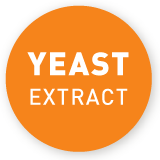The amino acid glutamate, which occurs in numerous foodstuffs, does not represent a health risk. This is generally true no matter whether the glutamate intake occurs as protein-rich or ripened foods, as the natural ingredient yeast extract or as the flavour enhancer monosodium glutamate – an isolated pure substance.
The expert Prof. Dr. Thomas Vilgis from the Max-Planck-Institute for Polymer Research in Mainz, Germany explains: “The discussion whether natural or artificial is simply misleading from a scientific point of view. How it was produced is completely irrelevant for the function of a substance during the cooking process and its effect on the organism if the molecules are identical.” Glutamate is – independent of its phenotype – metabolised by the body as an amino acid.
Yeast extract also contains an average of five per cent glutamate – in addition to lots of other amino acids and proteins from the yeast, which gives the ingredient its savoury flavour. Yeast extract is recognised as safe and harmless and has been used in food already for decades. Also the safety of the flavour enhancer monosodium glutamate was comprehensively tested several times. Already in 1987 the Joint FAO/WHO Expert Committee on Food Additives (JECFA) conducted tests with monosodium glutamate as an additive and concluded: No negative effects were to be expected from consuming the usual quantities occurring in foods. In 1991 the Scientific Committee for Food (SCF) of the then European Community followed the JECFA evaluation after further in-depth tests. Most recently the Hohenheim Consensus Conference, an independent experts meeting, addressed the topic glutamate and confirmed its safety in 2007. Amongst other things, the conference report emphasised that a multi-centre study on the consumption of added monosodium glutamate could not establish any negative effects that correspond to the alleged “China restaurant syndrome”. Both foods that are naturally rich in glutamate and also dishes that have added monosodium glutamate are therefore safe – the digestive tract of a healthy person possesses a sufficiently high capacity to metabolise the amino acids.



